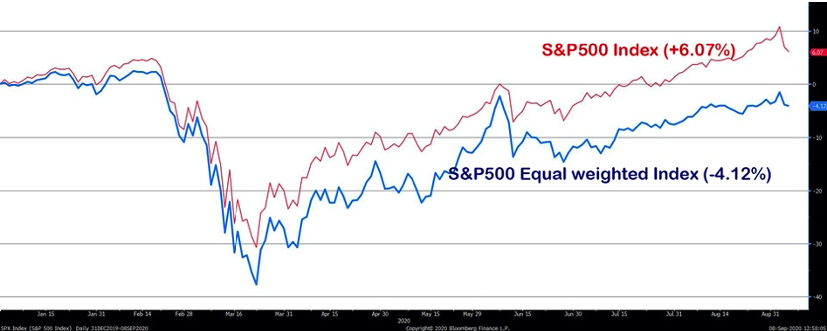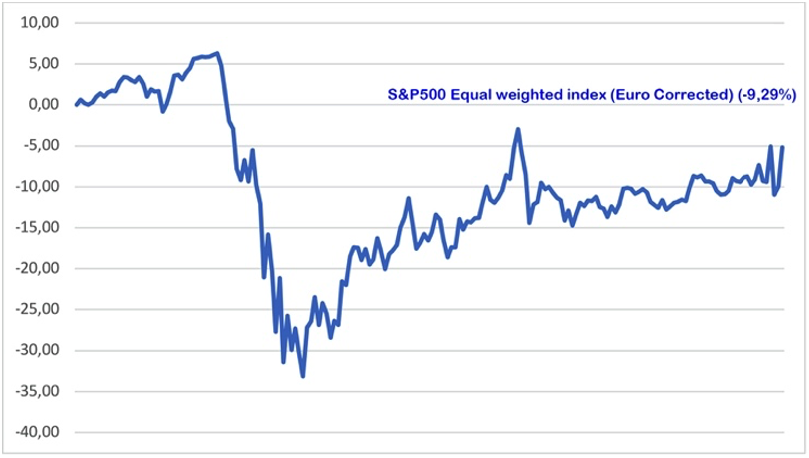10 Sep The column of Miguel Ángel, 10th of September 2020

Sometimes, as it happens now, indexes confuse us
At a time when the gap between the real and financial economies is one of the biggest differences ever seen, investors do not understand the reason for the differences in profitability between their portfolios and those index highs that we hear every day in the news. The stock market structure and the indexes that we usually follow must be corrected because otherwise we end up comparing pears to apples just because the skin of both is not rough. In this article I introduce something that is not new but serves us to know where we should most often focus our sight if we want to understand the sea in which we sail.

By Miguel Ángel Temprano
CEO Orfeo Capital
10th September 2020
Reading time: 4:50 min.
We are experiencing an unprecedented rise in the international stock markets. Above all, unparalleled by the radical discrepancy between the real economy and the “financial economy”. This is creating a gap that already has dimensions of a great sinkhole, as the cover of The Economist showed a while ago. Well, at least that is what they tell us. In this article we will see that this is true, but like most truths, only partially true.
Investors see that the indexes rise as if there is no tomorrow and they do not understand why their portfolios do not have a similar behavior, without stopping to think that the problem may not be in their portfolios, but in the indexes with which they are compared.
Let’s see what has happened so far this year. The S&P500 has not only recovered everything lost, but day after day it beats its historical record, taking a net gain for the year of 6%, and we all know that this is due to one thing only, to overbought of the technological ones.
But, although we all know it, we all stay at the same point, without even minimally reaching the next level of analysis, which is nothing more than assessing the weight that these technological values have in the index, that is, in the weighting that these have in the index.
Building a portfolio, diversified fund or a private, basically consists of three things: choosing the securities in which to invest – usually called stock picking – then determine the weight range of each value and finally determine the entry or exit criteria in the value. The later, the entry and exit criteria, are usually determined by valuation criteria, usually technical or fundamental and specific to each manager or investor. The second, that is, the weight of each security in the portfolio, is usually in a very narrow range, with limits generally close to the result of dividing the total amount to invest by the number of securities in which to do so. And the first is undoubtable the most complicated and in which success tends to lie, especially in trending markets.
And why do we do this? By a simple and straightforward diversification criterion. Now, we compare ourselves with indexes where these weights are not only not equal, but whenever a security is rewarded with a revaluation its weight in the index increases. So hypothetically we could find a bull market, if we look at the index, but where most of the values are bearish. Difficult, but not impossible, it’s just down to math.
So, why do we compare ourselves to weighted indexes if we do not weigh in the securities in our portfolios the same way? By doing this we are distorting the comparison and therefore the “Benchmark”. And this now hurts many portfolios, but other times the opposite happens, and this is unfair and uncertain in either of them.
So, what should we compare ourselves to? Well, with unweighted indexes. The kind that exclusively measure the price without taking into account its capitalization.
In the following chart we see a comparison of the S&P500 (weighted and unweighted). And curiously what the chart tells us is that the market as a whole has not risen as it seems it has, but rather so far this year it has fallen by 4.12%.
 In reality, when we analyze the prices one by one, we see that of the 500 stocks that make up the
In reality, when we analyze the prices one by one, we see that of the 500 stocks that make up the
S&P500, only 213 stocks are positive so far this year, that is, 42.6% of the total, while the rest is more 57% of the values are negative so far this year.
Unless we maintain an absolute technological position, a situation only typical of a thematic fund and of course very far from a typical diversification strategy of a multi-sector fund or a typical investor portfolio, our expectation of profit in the year is certainly not promising.
True? Things look different like this. And furthermore, do any of the readers believe that a bubble of dis-communal size is not really being created in these types of values? With which, not only do we compare ourselves wrongly, but we also compare ourselves against something that very few people believe reflects its real value and therefore with an exaggerated assumption of risk.
But let’s get into another curious dichotomy. The European investor uses the Euro as its reference currency. Very few investors, in fact, only the very large fortunes can have long-lasting positions in dollars, that is, for periods between 7 and 10 years without caring about the valuation against the euro. Thus, for any average European investor, the valuation of the currency is critical, so we must adjust the value of the index to either the price of the currency or, failing that, to the cost of hedging it, discovering that the situation in what is going in this year has only made it steadily worse comparing it to the beginning of the year.
 We can see in the following chart that the unweighted index and with the currency difference has contributed a negative result in the year of more than 9%. And I already anticipate that the same thing, obviously without currency correction, happens if we do the exercise with the Euro Stock 50, where the unweighted index has fallen 13% so far this year.
We can see in the following chart that the unweighted index and with the currency difference has contributed a negative result in the year of more than 9%. And I already anticipate that the same thing, obviously without currency correction, happens if we do the exercise with the Euro Stock 50, where the unweighted index has fallen 13% so far this year.
It is not my intention to justify any investment strategy or management. In this way I want to put the investor’s eye on a very exact way of how to see a situation that, as I said at the beginning of the article, is not always the same as it is painted.

